Impressions of Lenovo Miix 2 8: week with a tablet on Windows 8.1

The tablets on Wintel, that is, with the Windows operating system and Intel processors, have never really interested me. I’ll even say more - frankly scared. Perhaps, because the first contact with devices of this class I had back in the days of the Origami project. Then I received Samsung Q1 for a couple of days and was not thrilled - the device was slow, uncomfortable and just kind of strange. Another reason for this reaction was the fact that I had never dealt with tablets at all before. But alright, several years passed, and Windows 7 appeared on the horizon, and with it the “new generation” tablets. This time I had to deal with one “Chinese” who seems to be sold in Russia under a number of local brands. At the time of acquaintance with this product, I was already able to play well with the first iPad, and I imagined
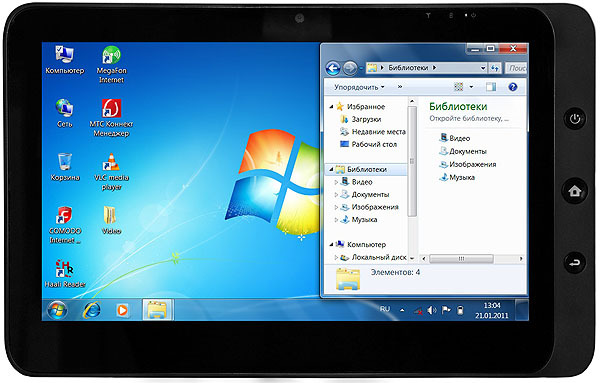
So that “Chinese” looked like
that. But what did I see in the “Chinese”? Coolers (no, not even that: COOLERS !!!) and, as a result, a thick body, just no optimization of the operating system for finger control, slowness and short battery life. Later, I also used a Dell tablet on Windows 7 for several days, I liked it a little more, but still I wrote the Wintel platform in the field of tablets to the dead ends of evolution and was no longer interested in such devices. Yes, I read the news, but in my head the content of the notes was not particularly delayed.
And in the yard in 2014 and Windows 8.1. Microsoft allowed partners to develop 8-inch tablets, finger-oriented panels [I’m talking about Modern UI, if anyone didn’t understand] were screwed to Windows [back in Windows 8], and Intel tablet processors learned to work normally without coolers. In fairness, I note that I have a Nokia BookLet 3G netbook with an Intel processor of the original Z-series tablet, which also has passive cooling. But this model is a separate song. I don’t know what Nokia and Compal (the partner of the Finns, who built this laptop) nodded about there, but BookLet works sooooo slowly by modern standards and even by the standards of netbooks of 2009, in which it was released. Apparently, they sacrificed performance for the sake of silence - they say that it’s better to stupid than to overheat.
So, closer to the point. Recently, sales of the Lenovo Miix 2 8 tablet began in Ukraine - this is just a small 8-inch tablet on Windows 8.1 without coolers. I used to catch a glimpse of the Acer Iconia W3 similar in capabilities, but I didn’t like the screen there. Lenovo, judging by the information provided during the announcement in October 2013, everything is fine with the display: an IPS matrix was reported, and browsers on the Web praised the screen. Well, I took Lenovo Miix 2 8 for a week - if I like it, I will replace it with Nokia BookLet 3G, which plays the role of a “portable workstation” and has already managed to get enough of it with its slowness.
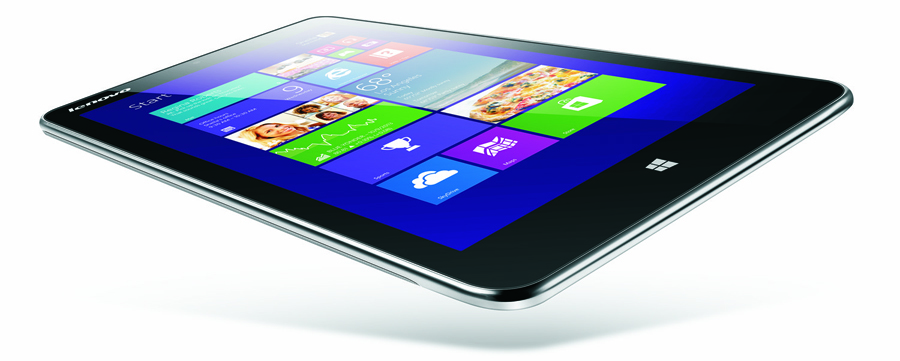
Lenovo Miix 2 8
I’ll immediately warn you that I have very specific requests and an operating model, so I won’t start singing odes for Modern UI and its convenience / inconvenience - I just don’t use it. Neither on a laptop (there, in my opinion, it doesn’t need anything at all - well, yes this is one of the most popular topics for contemporary holivars, I won’t arrange them here), or on Lenovo Miix 2 8. Why is that? Well, I just think that Microsoft was a bit overestimated - the usual interface with icons and vertical scrolling for mobile devices is much more convenient. Either in Redmond they were limited by some patents, or they simply tried to do it “not like Apple and Google,” but it turned out, in my opinion, to be average. This, I repeat, is solely my opinion, which does not pretend to be objective: I know a couple of people who are madly happy with Modern UI even on laptops. I imagine
I don’t know who is “to blame” for this - Microsoft, which somehow optimized the touch screen drivers, or Lenovo, which correctly calibrated it, but in desktop mode (that is, with the classic desktop), I easily get my finger into the smallest interface elements. Minimize a window or close it? Sure, not a problem. Select a line in the Windows settings? No problem: no mistakes at all. And this, mind you, on an 8-inch display with a resolution of 1280 x 800. That is, yes, many buttons / arrows / icons are very small, but I can get through them in most cases. This means that it is convenient to use the Lenovo Miix 2 8, it does not cause rejection, and compared to tablets on Windows 7 it is not even an evolution, but a revolution. In my, I emphasize the specific case.

What am I currently using from software? "Photoshop", "Chrome", "Word" (by the way, with 8-inch tablets on Windows 8.1 comes the free MS Office 2013 Home & Student), KM Player. I don’t need anything else on the tablet in most situations, because in fact the Lenovo Miix 2 8 is designed to solve small urgent tasks when it seems like a busy day, but due to good weather and mood I don’t want to sit indoors.
It would seem, why buy a tablet on Windows, if you open MS Office files and reduce the image in JPEG, can you use it on any Android device or iPad? Well, it’s for me personally to work closer to the Windows environment - even if you cut me. Meanwhile, Android and iOS are not suitable for some people in principle: as one of my friends said, looking at Lenovo Miix 2 8, “1C Accounting in your pocket ?! Dream!". Yes, this is a dream - the dream of those who use some kind of professional software, available only under Windows. But lovers of modern social entertainment (of which there are much more than professionals) are unlikely to like such tablets - the VKontakte client for Modern UI is crooked, Instagram isn’t at all ... And so on. You have to sit through a browser, which in the case of a mobile device is objectively less convenient than through a separate application.
ScreenLenovo Miix 2 8 probably does not have an oleophobic coating, since it gets dirty very quickly, and it is rather difficult to wipe. There are no complaints about the quality of the matrix: it is not inferior to the screen of the same Samsung Galaxy Tab 3 8.0, which also has 8 inches and 1280 x 800 pixels. Not Retina, of course, but I was even more worried not even about the clarity of the picture (it is acceptable), but her, we will say so, cleanliness. It’s just that I’ve seen tablets more than once - including on Windows - with a muddy image. Moreover, it was not a screen as such, but a protective coating that made the picture seem to be shiny, as if the coating was smeared with grease from the inside. Lenovo Miix 2 8 has no such problem - the image is high-quality, viewing angles are moderately wide.
In general, the release of 8-inch tablets is absolutely the right step on the part of Microsoft associates. 10-inch models are too large, they are not very convenient to carry, but the "eights on the eights-with-unit" are already little different in size from their counterparts on Android. So, with a direct comparison, it turns out that the Lenovo Miix 2 8 is only slightly larger than the Samsung Galaxy Tab 3 8.0. In the hands of this difference is not noticeable at all, which is very cool. A tablet weighs 350 g - again, almost as much as the analogs on Android.

Top - Samsung Galaxy Tab 3 8.0, bottom - Lenovo Miix 2 8
CaseLenovo Miix 2 8, in my opinion, is of average quality. That is, the materials are pleasant, but occasionally something is slightly staggering inside, and the back cover - they say that it is made of metal, but, in my opinion, it is still such plastic - no, no, and it’s “buzzing” under your fingers. The metal part is also at the very bottom. It is extremely quickly scratched. In general, this “Lenovo” is very far from the iPad, and even to my Samsung Galaxy Tab 3 8.0.
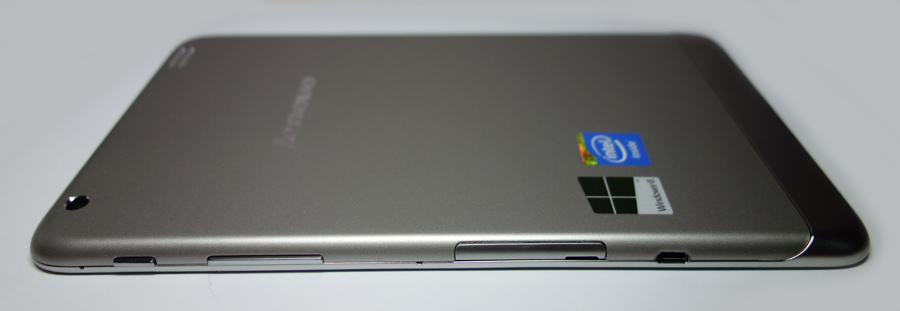
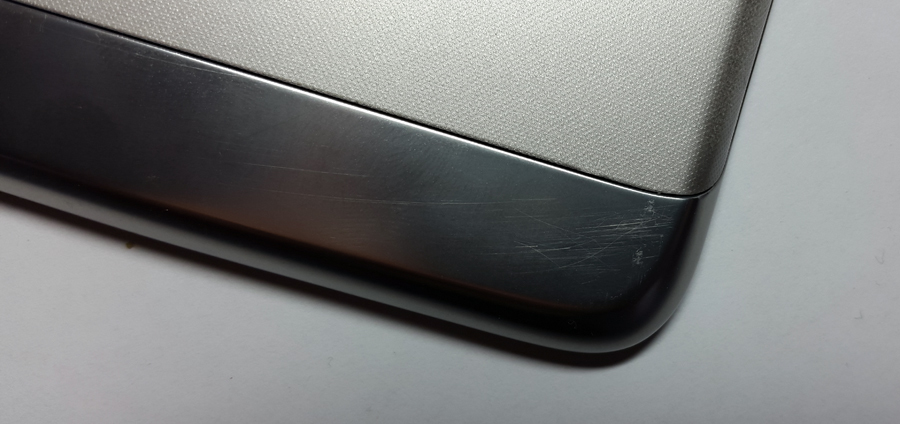
64 GB of memory is installed in the “my” copy of Lenovo Miix 2 8, of which no more than 33 are available. There is also a 32 GB version, I do not advise taking it - there will be very little space. Although, of course, it can help out a microSD slot (including 64 GB cards are supported), but, as I understand it, applications for the Metro UI cannot be put on a USB flash drive, so if they are modified with a capacity of 32 GB, there will be too little space.
Lenovo Miix 2 8 uses Intel Bay Trail-T platform, including a 4-core Atom Z3740 processor with a frequency of up to 1.33 GHz, paired with 2 GB of RAM. It is difficult to say what the model will have with speed, because it is Windows. While both interfaces - both tiled and desktop - work very (very straightforwardly) smartly, but over time the “windows” may become cluttered, which will lead to a drop in speed. It is clear that this can and should be fought, and yet.
In the game I Lenovo Miix August 2 is not played, or rather, a couple of times ran Asphalt 8 Modern UI. Well, nothing special can be said here - the toy looks exactly the same as on the Galaxy Tab 3 8.0.
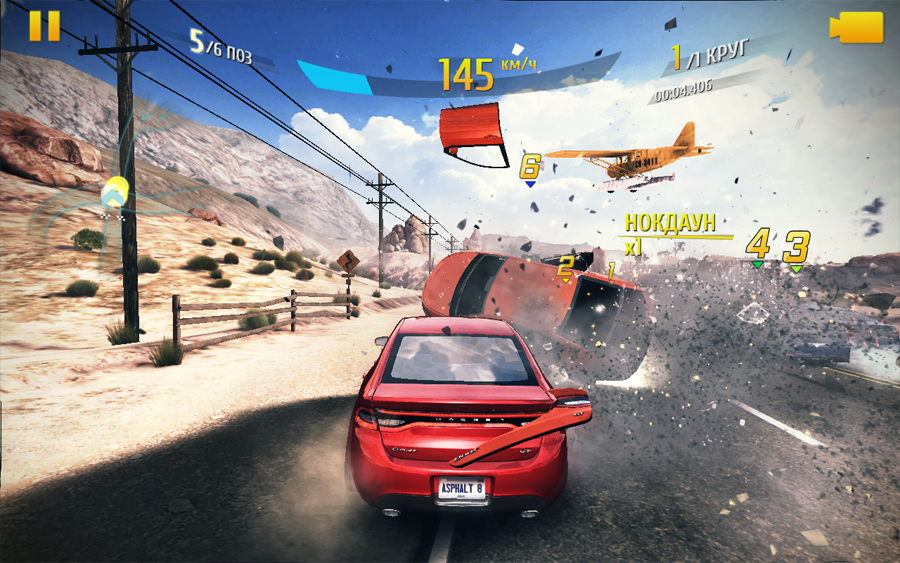
Asphalt 8 on Lenovo Miix 2 8
What am I missing on the Lenovo Miix 2 8? Perhaps the built-in 3G modem. Everything is somehow strange with him. On the forums they write that someone once somewhere saw a version of this tablet with such a module, but I could not find it on sale - and over the hill, and even more so with us. There are several options for solving this issue. I chose the following for myself: I simply transfer the smartphone to the access point mode when you need to connect to the Internet from a tablet. The second option is to buy the so-called MiFi - a pocket router with a battery. The third is to connect the “whistle” to the Lenovo Miix 2 8 through an adapter. It will not work directly, since there are no full-format USB ports on its case, only microUSB, and this is a minus of the device. By the way, the tablet is charging just through this port, and if the modem (well, or, for example, a wired keyboard, if you decide to connect it) has to be deleted during recharging.
If we are talking about the minuses , then I will mention one more - a rather weak speaker . The sound is flat, quiet, and because of this, watching a movie on the Lenovo Miix 2 8 movie is less pleasant than on most tablet computers that I have dealt with before. But with the viewing time, everything is relatively good: I specifically turned on Full HD recording (I know that there is no special sense in this resolution in this case, nevertheless) in KM Player in a circle with brightness set to maximum and wireless modules disabled. The tablet turned off after almost 8 hours. And so the batteries last for a couple of days - if you use the device fragmentarily, that is, check the mail from time to time and, say, edit a couple of documents in Word.
Finally, I’ll give a couple of shots from the built-in 5-megapixel camera . Although in general, of course, fotkat something tablet seems to me a little unnatural.

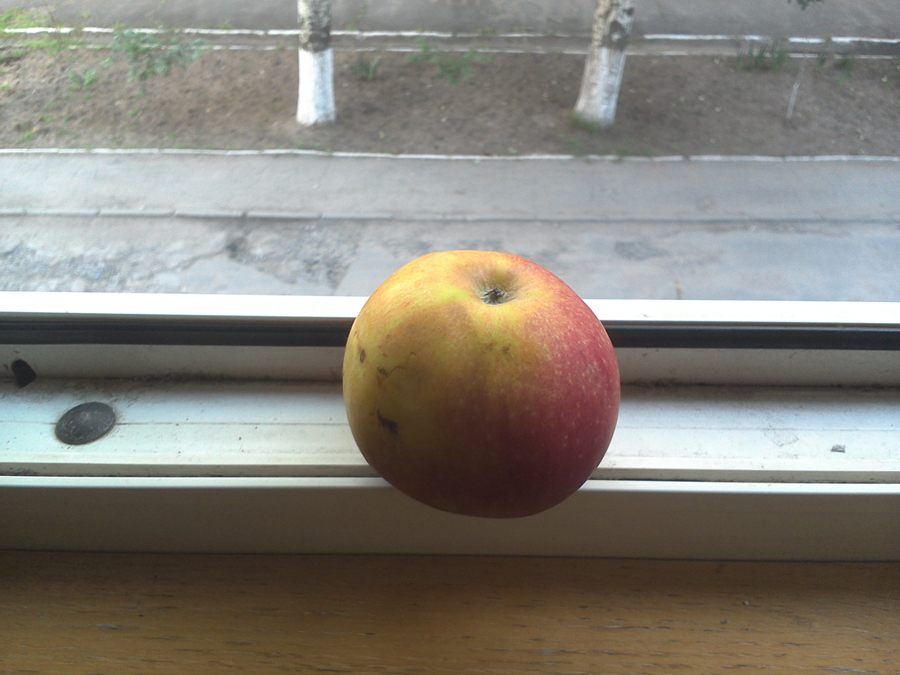
To summarizeI will say the following. Tablets with Windows 8.1 - especially 8-inch ones - have the right to life. Such models, fortunately, have little in common with their bulky and noisy predecessors running older versions of this OS and with older processors inside. In terms of size, they are practically not inferior to their Android counterparts, in terms of convenience ... Well, of course, an ordinary person who spends half of his free time on Odnoklassniki hardly makes friends with Windows on a tablet. If your work requires constant contact with the Microsoft operating system, and stealthily leaving the workplace in broad daylight, I really want to, like me, then yes, such a tablet can be a good option.
As for the Lenovo Miix 2 8 specifically, this, of course, is not an ideal solution - it has drawbacks. But I liked this product - for its price (4,200 hryvnias, about 11 thousand rubles; by the way, it doesn't seem to be officially delivered to Russia) it's a sin to complain. And then I still remember the times when an average tablet with Windows 7, a cooler, a finger and a half thick and autonomous at 5 o’clock, cost almost a thousand dollars. Times, fortunately, have changed. Wintel has also changed in tablets. Not as expeditiously as we would like, but it’s better that way than not at all.
Specifications Lenovo Miix 2 8:
Screen: IPS, 8 inches, 1280 x 800 pixels
Processor: Intel Atom Z3740 (Bay Trail-T), 4 cores up to 1.33 GHz, Intel HD graphics
Memory: 2 GB RAM and 32/64 GB ROM
Memory cards: MicroSD up to 64 GB
GPS / GLONASS: Yes
Wi-Fi: Yes
Bluetooth: Yes
Front camera: 2 MP
Main camera: 5 MP (autofocus)
Ports and connectors: MicroUSB, 3.5 mm
Average runtime: up to 7 hours (official data)
Dimensions: 216 x 132 x 8.4 mm
Weight: 350 g
